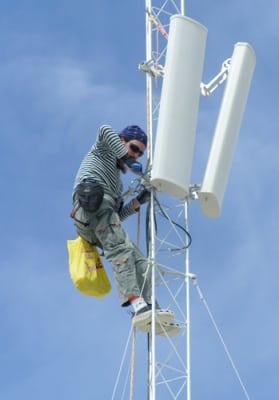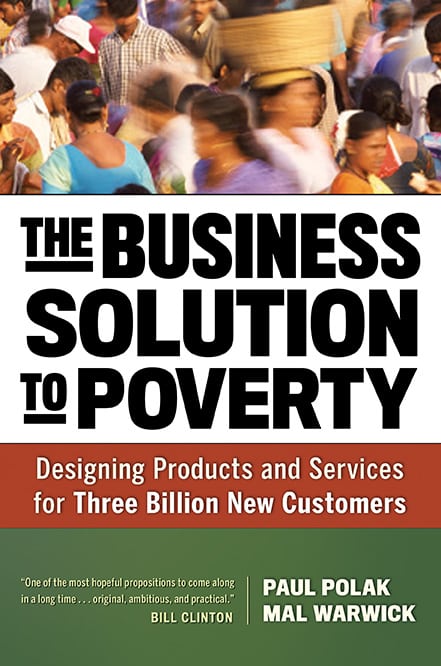In the developing world, cell phones come before land lines. Why? Because installing cell towers is cheaper than running landlines. But even with lower costs, telecom companies avoid the poorest and hardest-to-reach areas. Where they do provide coverage, it’s expensive, especially for the 3 billion people in the world who earn about $3 per day.
A small team of telecom industry veterans has solved both of those problems. The team developed OpenBTS, an open-source, software-based cellphone network. Not only does it cost one-tenth as much as traditional networks, but carriers could charge callers about $2 per month and still make a profit.
To do that, OpenBTS has stripped some of the opacity from cellphone service, turning it into a do-it-yourself project. Now, anyone with some technical chops, a Radio Shack nearby, and $4,500 can make a network that works with a standard GSM cellphone. In sum, this project could change how most of the world communicates.
By lowering costs, an open-source network like this one opens doors to small companies that are willing to provide coverage in the world’s under-served communities. This kind of network can’t sidestep the world’s AT&Ts – operating an unlicensed network is illegal in many countries. But it presents investment opportunities that could lead to fundamental shifts in regulations, especially if it becomes clear that this is a cheaper way to talk.

Here’s a look at the OpenBTS hardware. Photo courtesy of David Burgess
How it works
OpenBTS (BTS= Base Transceiver Station) is a low-cost replacement for a traditional cell network. It allows cellphones to connect to each other if they’re all within range of the transceiver, and to connect to any other phone in the world through an internet connection.
At its core is open-source software that creates an interface for cellphones to connect to the network. The software is installed on a computer with a Linux operating system. An open-source device, called a Universal Software Radio Peripheral (USRP), plugs into the computer. Together, they create a signal that looks just like any signal for GSM phones. GSM, by the way, is the most widely used cellphone standard in the world.
To complete the trick, the software plus the USRP hardware links to an open-source PBX called Asterisk. The PBX, a private branch exchange, is a server that acts like a switchboard to place calls.
With that set-up, anyone in range of the signal can place calls to anyone else in range, exactly as if they had traditional cellphone coverage. To connect to the rest of the world, all that’s needed is an internet connection.

The OpenBTS team is on a tower on the Polynesian island Niue, where they tested their network last year. Photo courtesy of David Burgess
Low, low, cost
“Our goal is to drive the cost of the service down low enough and operate a profitable business to provide low-cost service to literally billions of people. Because they’re out there and they can’t afford the current system,” said David Burgess, one of the three brains behind OpenBTS.
A phone company would have to invest about $200,000 to install a network in a rural, off-the-grid village. That would cover a few thousand people in a radius of about nine miles (15 kilometers). Because there’s no power, the company would need a generator. If the generator runs on imported diesel, then fuel, plus delivery and security expenses, could cost $12-18,000 per month, Burgess figures.
A comparable OpenBTS network would cost about $20,000. That includes solar panels, so the power would be nearly free. At that price, a monthly calling plan could cost about $2 per month, Burgess says. And, with future improvements, he hopes to drive the cost to the user down to $1 per month.
Streamlining regulations
Burgess’ team is working with carriers in Latin America to install OpenBTS networks in their coverage dead zones. And these arrangements won’t be the network’s first time in the field.
In the past three years, the team successfully field-tested OpenBTS at two Burning Man events in a (mostly) dead zone in Nevada’s Black Rock Desert. The network also went to Niue, a Polynesian island with no coverage.
On Niue, the OpenBTS team learned a lesson about regulations. The island’s internet coverage is on the same frequency as the network, so it interfered with the signal. In most of the world, the law has set that range aside for cellphone networks. But not on Niue.

This is the OpenBTS network installation at Burning Man. Photo courtesy of David Burgess
Elsewhere, OpenBTS networks (and others like it) could butt heads with the opposite problem: too much regulation. Legalizing even a small network in the United States requires an FCC license as a first step, followed by other bureaucratic hurdles. If small, open-source networks catch on, Burgess foresees an overhaul of the world’s network laws. That could open doors to small businesses that are shut out of the industry now by high costs and strict regulations.
“Certainly there are technical hurdles to driving the cost down. There are also regulatory and political hurdles,” Burgess says. “But we believe that when you prove it is possible and change the way that people think about it, you’ll see new opportunities. You really change the whole nature of the business.”
Cell phones for better health
The world is already snapping up cellphone subscriptions. The number should top 5 billion this year, according to a UN study released in February. Such coverage is easing problems of poor development. People in developing regions are using their cell phones for everything from healthcare to financial transactions.
“Even the simplest, low-end mobile phone can do so much to improve health care in the developing world,” Hamadoun Touré, Secretary-General of the International Telecommunication Union said in a statement. “Good examples include sending reminder messages to patients’ phones when they have a medical appointment or need a pre-natal check-up. Or using SMS messages to deliver instructions on when and how to take complex medication such as anti-retrovirals or vaccines. It’s such a simple thing to do, and yet it saves millions of dollars and can help improve and even save the lives of millions of people.”
Burgess agrees. “There are very few people in the world who would refuse telephone service by choice. But there are lots who can’t afford it,” he says.
For more information, please see the OpenBTS site. For the source code, there’s the OpenBTS wiki. And Lee Dryburgh posted an audio file and a transcript of his very technical interview with David Burgess at the Emerging Communications Conference in 2009.

This is the command center for the Burning Man test. Photo courtesy of David Burgess


saludos y esta buenisimo quisiera probarlo
Hola me interesa micho este proyecto pero necesito mas informacion
dear rob,
we are looking at funding the installation of an open bts in an island COMMUNITY in indonesia. do you know who we should be talking to about this?
regards & thanks,
Alistair
Hi Alistair, thanks for your interest. You can try asking Kurtis Heimerl: https://www.eecs.berkeley.edu/~kheimerl/. Good luck, and please let me know how it goes if you get a system set up. I’d love to post pictures.
this interests me very much. i would love to experiment with this tech.